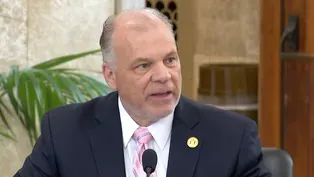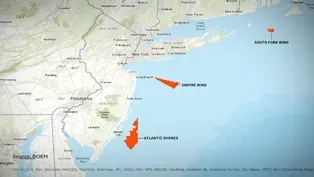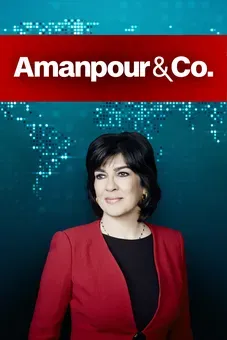NJ Spotlight News
Climate change threatens clam fishing industry in NJ
Clip: 12/11/2023 | 14m 31sVideo has Closed Captions
Climate change is threatening clam fishing industry in NJ
If you’ve ever had fried clam strips or a bowl of clam chowder, chances are you’ve eaten Atlantic surfclams from New Jersey. The Garden State is the hub of the fishery. But climate change and offshore wind development are some major issues fishermen are facing. Now scientists are working to raise new strains of surfclams, which may one day be able to survive and thrive in new conditions.
Problems with Closed Captions? Closed Captioning Feedback
Problems with Closed Captions? Closed Captioning Feedback
NJ Spotlight News is a local public television program presented by THIRTEEN PBS
NJ Spotlight News
Climate change threatens clam fishing industry in NJ
Clip: 12/11/2023 | 14m 31sVideo has Closed Captions
If you’ve ever had fried clam strips or a bowl of clam chowder, chances are you’ve eaten Atlantic surfclams from New Jersey. The Garden State is the hub of the fishery. But climate change and offshore wind development are some major issues fishermen are facing. Now scientists are working to raise new strains of surfclams, which may one day be able to survive and thrive in new conditions.
Problems with Closed Captions? Closed Captioning Feedback
How to Watch NJ Spotlight News
NJ Spotlight News is available to stream on pbs.org and the free PBS App, available on iPhone, Apple TV, Android TV, Android smartphones, Amazon Fire TV, Amazon Fire Tablet, Roku, Samsung Smart TV, and Vizio.
Providing Support for PBS.org
Learn Moreabout PBS online sponsorshipI've been in the industry since 1983 got in when I was 21 years old.
So just about 40 years ago I just fell in love with it.
I took one trip and that was it.
I was hooked.
I just fell in love with the freedom, the camaraderie of the crew.
The, the, the competition between boats it's just it's, it's.
It's a great living.
I like to tell people that New Jersey is not just the Garden State, it's also the shellfish state.
A lot of people don't realize just how important shellfish are to the economy of the state.
There's shellfish fisheries that are major, major commercial fisheries.
And there's also a lot of aquaculture that happens in the state.
So annually, the industry is the industry's bringing in 2 million, 2 million bushels out of a quota of 3.2 million.
So for the fishery annually coast wide, we're talking about a $30 million fishery.
So this is Atlantic surfclam.
You've got the, you've got the tongue along the front.
There's two abductor muscles that keep that that keep that shell close.
And that's a nice looking high value clam there.
Surf clams is really it's a species of clams and they're a species that lives in the ocean.
So if you're standing in Ocean City, New Jersey, and you're looking out at the ocean, you're looking out towards where the clams live.
These are clams that have been a major part of the commercial fishery in the state for a long, long time.
They're a species that is converted into all kinds of food products that you might know clam chowder, for example, or chopped sea clams that you'd get in a can or even clam strips that you might get at the at your favorite pub on the shore.
We're seeing clams move off shore because of because of the warming waters, because of global warming.
So New Jersey actually had a very vibrant inshore fishery, which when I say inshore we're talking from the coastline about three miles.
That fishery is gone.
A lot of the research questions that we address in my lab come from conversations with both fishermen and farmers who either want to know about how how their these animals are responding to changing climate conditions or how the ecosystem is interacting with these species.
You know, the health of a certain clam matters to these guys.
We actually know quite a bit about surf clams.
And from what we've known, we think that they're sensitive to stressful temperatures.
We think that they may be responding also to ocean acidification in certain negative ways.
And so some of what we're doing here now is to try to really understand the mechanisms of what's happening there.
We also don't know if maybe they have the capacity to adapt to these changing environmental conditions.
The species has a calcium carbonate shell, so it's really susceptible to changes in PH if waters or to acidify it.
It's really difficult for juvenile organisms to be forming their shell or it can affect things like shell strength.
Ocean acidification is certainly one thing that often we predict to be more extreme in the future.
But something that's already happening right now and specifically this year is changing ocean temperatures and so this is why for this project, we're really interested in the combined effects of thermal stress.
So water that's getting warmer and also ocean acidification PH going down.
And we know that there's a warming effect is already happening this year.
We have some extremely warm ocean temperatures even compared to more recent years.
And we believe that the sea changings and water temperature, that's already changing the distribution of the surf clam.
So the range of actually where they're occurring is already thought to be changing into a more northward and offshore location.
There's a big transition going on right now in New Jersey as far as sustainable energy production.
Right, green energy.
And one of those things is offshore.
The development of offshore wind.
Offshore wind will be in particular off the coast of New Jersey, occupying habitats that are surfclam habitat.
These turbine foundations and some of the other infrastructure that's going to be put in are going to be put in where surfclams live today.
It's also areas where the surfclam fishery goes out to catch surf clams.
And so it's really important for us to try to understand how that nexus is going to work.
The nexus of climate change, offshore wind energy development and surf clams, both the fishery and the biology.
And I'd say right now we don't really have a very good way of understanding what that will look like.
I mean, it's hard for people to imagine what it's like operating in a large boat in the open ocean.
But you are in the open ocean.
And if you put if you put these turbines, whether it's every seven tenths of a mile or every mile, and you ask this fishermen to fish around those, those are hazards.
Right.
And when he fishes around those hazards, there is a consequence that if he comes into contact with that high voltage cable or his vessel comes into contact with that structure, there's a consequence to that.
Right.
There'll also be a certain interaction with the fishing vessels that will prevent them from going out and getting clams in some of these areas, because of cables and other infrastructure.
And so there's certainly going to be intersections.
There's no question that there will be interactions and impacts what those will look like in the consequences of those are very uncertain at this point.
I'm very concerned and I'm very optimistic.
All right.
I'm concerned that the regulators aren't going to get it right.
I'm hoping that they can.
Through Rutgers and some of the developers are actually chipping in for research to see if we can come up with mitigation, where we enhance the stock by actually planting seed outside of the wind energy areas to replace what we're losing access to with inside the wind energy areas.
This is something that that through the proper research, we can figure it out.
We just need the regulators and the developers to come along, put the put the right amount of money into into the research, give this a go.
Include mitigation for the surfclam industry as stock enhancement in their construction and operation plans.
Everybody get on the same page so that so that these two industries can really coexist.
And maybe we can do it There's interest in farming surfclams.
And that would mean a very different way of producing our farms as food in the wild fishery when the boats go out to collect the clams and fish them, they're fishing on very big old clams.
These clams live to 40, 30, 40 years.
And so that product is a very different product than something that would be produced on a farm over the course of one to two years, which would be a much smaller clam.
So an aquaculture surfclam might look very different than a fish surfclam.
But nonetheless, there's there's a great deal of interest in trying to find a way to grow that species sustainably on farms in the ocean and in the back bay.
We are standing at my shellfish nursery in Great Bay Marina, Little Egg Harbor.
The family business goes back in 1909 and in the early days natural resource was abundant and it was a Darby fishery anybody you or anybody with a license could go out and earn a pretty good day's pay and you would bring that catch into My great great grandfather, my great grandfather, my grandfather and that day unload your boat get paid and go home.
Things have changed dramatically.
The natural resources is very much depleted.
There's a there's some remnant wild recruitment, but it's nothing like it used to be.
So to meet the demand of the market we farm, raise the majority of our shellfish being hard clams, oysters.
We've grown a few scallops, and now we're trying to grow surfclams.
So water's pumped in from the marina.
These tanks are called upweller tanks, water manifold supplies water to each tank.
The tanks constantly fill and constantly drain.
It runs in through the oysters or clams and runs out.
We don't use it twice.
Just single use water.
Surfclams are right here.
This one's all surf.
This one's all surf.
That one's all surf.
We had.
We did the math.
There's about a million.
You got about a million surfclams here.
A couple of the big advantages that a farmer might see in growing a surfclam is they're very fast growers.
They grow very, very quickly.
So they're easy to handle in the hatchery.
So the seed production side is quite easy, and they're a delicious product.
They look really great on a plate and they're very, very tasty meat.
They taste very different than what a consumer might otherwise expect as a clam that they might get at a restaurant.
And so there's a number of things that make them a potentially desirable farm product.
And there are a number of farmers interested in trying it.
And so we're kind of at this early stages of developing surfclam aquaculture.
So a wild surfclam that you would see like wash up on the beach.
It's probably six or seven years old and that clam is gets harvested and processed for fried clam strips.
It goes to some machinery, gets steam sliced and frozen in a block and it goes out to a fryer to get fried in the strips.
What we're trying to do is grow them to a steamer size where the whole clam gets steamed and the whole meat of the clam goes into the can as whole clams can.
It's a different product, same species, same meat just a different product.
They're very sensitive thermally.
You know, they react to drastic temperature changes.
So as they grow larger and they become more prone to those temperature changes, we have to look at what we expose them to.
And again, that's part of selecting the brood stock that we're going to use for the next generation in the bay.
We can select for clams that could tolerate more of a temperature change, more of a salinity fluctuation, versus those that have adapted to live out the ocean indefinitely.
They're fast.
They grow fast.
So as a farmer, when I look at when I purchase my oysters, my hard clams, whatever I'm farming, it's your investment.
It's money out.
The faster that shellfish is going to grow.
The sooner you get to return.
There's a very strong market.
And if we can manage to produce enough of the right size surfclam, it'll be the first farm raised surfclam to get canned.
When I think about the future of shellfish both farming and fishing.
I'm optimistic.
I think that there's a lot of interaction between managers who are responsible for sustaining the resource and making good decisions.
Scientists who are, and not just me.
There's a number of really amazing scientists in this field who are doing work to support sustainable decision making.
And then there's the stakeholders, like the farmers and the fishermen who are really they're at the table doing the hard work.
And don't question for a second whether shellfish farming is hard work.
It's very, very hard work.
Fishing, very, very hard work.
And these people are there doing that hard work because they believe in the product they're fishing for.
And so it makes me optimistic about the future.
I think there are certainly challenges related to other user groups like offshore wind or climate change, environmental change.
But I think that I think that there's ways to overcome these challenges.
And I am optimistic about the future.
Former NJ Senate President Steve Sweeney to enter gov. race
Video has Closed Captions
With the potential announcement, Sweeney joins the Democratic race with Steve Fulop (1m 25s)
Mobile grocery store comes to Atlantic City
Video has Closed Captions
Prices are 30 to 50% less than supermarket, making it more affordable for families (3m 51s)
NJ Jewish communities celebrate Hanukkah in difficult times
Video has Closed Captions
Festival of lights starts amid rising fears of antisemitism (4m 10s)
NJ solicits bids for new offshore wind projects
Video has Closed Captions
Development continues after Ørsted pulls out of NJ (3m 51s)
Questions about NJ's crisis pregnancy centers
Video has Closed Captions
Planned Parenthood NJ report said the centers are not health centers (4m 33s)
Rutgers to name chair for LGBTQ public health
Video has Closed Captions
Interview with Perry Halkitis, dean of the School of Public Health at Rutgers University (4m 18s)
Providing Support for PBS.org
Learn Moreabout PBS online sponsorshipNJ Spotlight News is a local public television program presented by THIRTEEN PBS

















